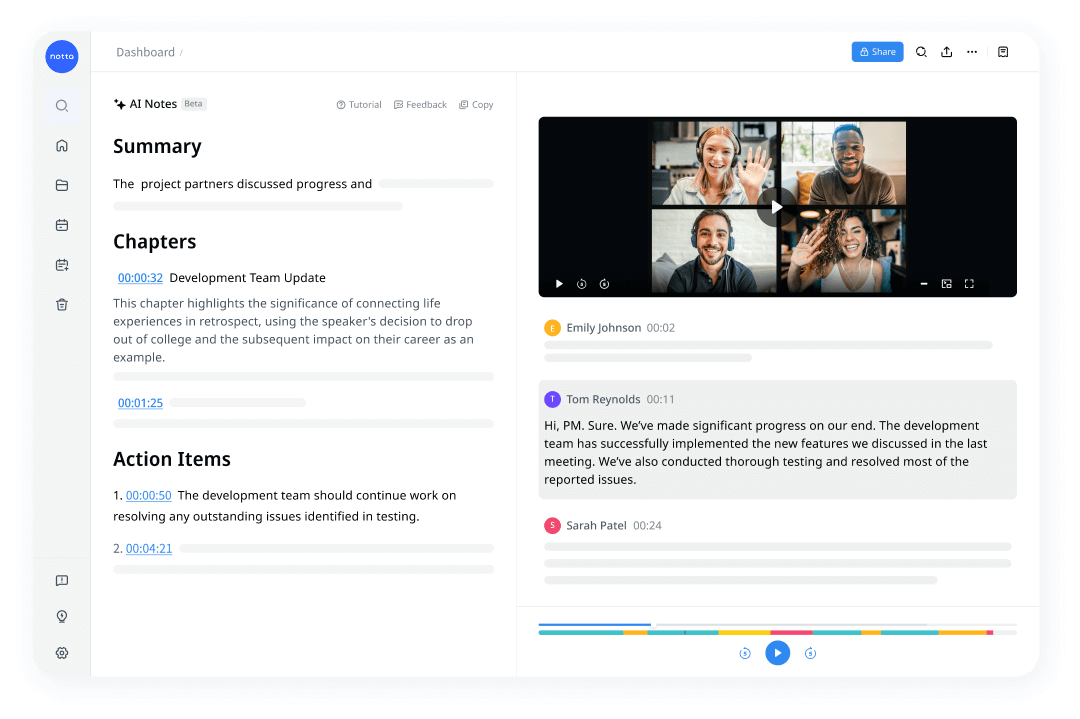
A Complete Guide to Remote Employee Engagement: Ways & Ideas
Record, transcribe and summarize conversations with one click.
Remote work has been on the rise in recent years, offering employees the flexibility to work from any location as long as they have an internet connection. However, remote work can be challenging, especially when it comes to maintaining a sense of connection and community with colleagues.
Research indicates that around 20% of remote workers struggle with loneliness, which can have a negative impact on both their well-being and the company culture.
However, there is good news, too — social connectivity in remote work environments can boost productivity by two to three times. Therefore, it's essential to engage remote employees on a routine basis.
If you want to keep remote workers engaged and happy, we have some fun tips and ideas that will get you started smartly.
The importance of engaging remote employees
Employee engagement refers to the extent of an employee's dedication, commitment, and connection to their organization, as well as their involvement with the company's culture and colleagues.
So, how to gauge employee engagement? One effective method is to inquire about the employee’s work and passion levels directly.
High engagement lever has a positive correlation with employee performance:
Individuals who are more engaged tend to display higher levels of efficiency and job satisfaction and go beyond their job requirements when possible.
Companies with highly engaged employees are reported to be 17% more productive.
Therefore, businesses must employ unique ideas and fun team-building activities to foster employee engagement. Such practices help strengthen team connections, boost employee morale, and enhance productivity.
Managers' role in remote employee engagement
Managers and leaders should take the initiative and hold significant responsibility to keep remote employees engaged.
They are tasked with communicating the company's vision, values, and objectives to their team members, providing constructive feedback, recognizing and rewarding outstanding performance, and offering growth opportunities to help employees advance in their careers.
They must develop effective strategies to create a positive work environment that fosters employee well-being. Here is how they can help:
Have routine remote one-on-ones with employees to address their questions and concerns.
Create opportunities for employees to engage in informal conversations about non-work topics, as it helps foster a sense of community.
Offer support and encouragement to team members when they face challenges.
Top 8 ways to keep remote employees engaged
Here are some effective tips to keep remote employees engaged and connected to their colleagues, even from miles away.
Ditch micromanagement
Leaders tend to micromanage when managing a remote team because they sometimes feel like losing control and lacking trust within the team; however, this is the first thing to avoid.
Remote workers are often more productive and satisfied than their office counterparts because of the increased freedom they have in terms of when, where, and how they work.
So, as managers, it’s okay to add a little more communication effort but avoid closely monitoring their work hours, dictating how they should perform their tasks, or even requiring constant check-ins or updates.
As long as they are meeting their goals and completing their work on time, it's essential to allow employees to work in a way that works best for them.
This requires you to establish a framework that promotes individual accountability for achieving goals. Utilize a combination of SMART goals, OKRs, and KPIs to offer autonomy to remote employees.
Set clear expectations
Speaking of micromanaging: one way to combat this is clearly communicating the team's goals and how you expect each member to contribute.
Here are some key points to keep in mind when setting expectations for remote employees:
Clearly define the roles and responsibilities of each team member, including their specific tasks and deliverables.
Establish clear guidelines for communication, including what channels to use, how often to check in, etc.
Communicate your expectations for performance, including quality, quantity, and deadlines. Be specific about the metrics you will use to measure performance and provide regular feedback to help team members stay on track.
Recognize that remote work can be challenging, and be willing to be flexible when necessary.
Use technology to enhance communication and collaboration
Technology has revolutionized the way we communicate and collaborate with others, making it easier for remote employees to work together regardless of distance.
You can use the following technologies to make remote work more efficient:
Video conferencing tools: These tools are a must in remote and hybrid workplaces. You can have virtual meetings with anyone from anywhere in the world. To make online meetings more productive, try Notta AI which not only records the calls alongside a full transcript but also generates a meeting summary automatically, therefore getting the best out of each meeting.

Chat platforms: Platforms such as Slack, Microsoft Teams, and Google Chat enable you to talk to your team in real time without dealing with those boring email threads.
Cloud-based collaboration tools: Teams can utilize cloud-based collaboration tools such as Google Drive, Microsoft OneDrive, and Dropbox to store and share documents, enabling simultaneous work on the same files.
Project management tools: When it comes to managing projects, Asana, Trello, and Jira are some of the top-notch tools available. They aid teams in monitoring progress, delegating tasks, and fostering collaboration, which gives a clear overview of the project status. With these tools, the team stays on the same page throughout the project lifecycle.
Streamline your meeting documentation process with Notta AI meeting assistant. Easily search, review, and share meeting notes.
Recognize employee contributions
Remote workers may feel undervalued if their hard work goes unnoticed. So, providing regular feedback and recognizing employees' contributions, individually or as part of a team, creates a sense of appreciation and acknowledgment.
To demonstrate appreciation for their employees' daily accomplishments, companies can introduce a rewards and recognition program. Here are some ways to appreciate remote employees:
Sending virtual birthday greetings such as e-cards.
Acknowledging their accomplishments personally by sending a thank-you message.
Offering gifts and bonuses like an electronic gift card.
Public recognition, for example, sending a team-wide or company-wide email detailing an employee’s exceptional performance.
By offering recognition, employers not only become better employers but also cultivate friendly competition among employees.
Prioritize the holistic well-being of employees
It's important to ensure remote employees can access the same wellness resources and benefits as in-office employees. While companies may offer ergonomic office equipment, healthy snacks, and gym access in the office, these benefits are not available to remote workers.
To address this, consider offering a catalog of ergonomic home-office equipment that remote employees can order from. You could also partner with on-demand wellness apps such as WellBeats, Calm, and Headspace to provide them as benefits to your remote employees.
Additionally, it's important to educate remote employees about work/life balance and let them create boundaries between work and life because this is often neglected.
Boost mutual support with an accountability partner
An accountability partner is someone who helps you stay accountable for your goals and commitments. In the workplace, this person is typically a colleague who you trust and respect.
The idea behind having an accountability partner is that it can be challenging to stay engaged and motivated when working on long-term goals, especially for employees working remotely. Therefore, the accountability partner will provide support and encouragement and help colleagues stick to their priorities.
By keeping in touch through messaging, email, or regular one-on-one meetings, accountability partners can stay aware of what their colleagues are working on and offer feedback, celebrate successes, and help overcome obstacles.
This level of support and connection can be especially valuable for remote employees who may feel isolated or disconnected from their team.
Offer professional development opportunities
In a remote or hybrid work model, workers may feel like they're missing out on opportunities for growth and development. So, it’s important to provide remote workers with the same opportunities as in-office workers, such as encouraging them to participate in training and development programs, online courses, or coaching sessions.
This not only allows remote employees to work on their professional growth but also allows managers to track their progress and provide better oversight.
Provide extra support to new employees
According to research, 76% of new hires working remotely are more likely to feel less equipped to handle their job than tenured employees. This highlights the importance of offering extra support to new remote employees during their onboarding.
Managers should ensure that new remote employees receive adequate training, communication, and resources to help them adjust to their new work environment. This includes access to essential information such as login credentials and documents, as well as clarification on working processes.
9 best virtual employee engagement ideas
There are many ways of boosting engagement with remote workers, from virtual team-building activities to in-person gatherings and offering bonuses.
You may view the following as a "starting point" and customize them according to your company's specific needs.
Sending small gifts
Uplift the spirits of your remote team members by sending them surprise gifts throughout the year. They need not be expensive and can include simple yet thoughtful items such as headphones, books, or movie passes.
It's not about the material value of the gifts, but rather the act of sending them that makes it special and enjoyable to receive a surprise package in the mail.
Spotlight employees on public platforms

Set up a Slack channel, and create an email thread or a social media post where everyone can appreciate their fellow team members. This is the perfect opportunity for peers to show appreciation for their colleagues, managers to appreciate their direct reports, direct reports to shout out their managers, and even cross-departmental shout-outs.
Play fun online games
Here are some online games to engage your remote coworkers:
Online scavenger hunt: A virtual version of scavenger hunts where participants search for items that can be found in their homes.
Digital card games: Classic cards such as Checkers, Go Fish, and Match Up can be played online.
Codenames: A team game where players guess which words in a set are related to a hint word given by a teammate.
Online Trivia: A game where players compete against each other to see who knows the most.
Online Pictionary: A game where players draw a picture, and others guess what it is.
Try a Ted-style talk
Ask your team members to jot down something they’re good at outside of work, such as baking delicious cakes or having a knack for photography.
Help everyone create a quick slideshow and prepare a talk within five minutes. During virtual meetings, assign one team member to give a Ted-Style Talk at the beginning or end. After each talk, give two to three minutes for Q&A.
This is a fantastic way to boost team engagement during virtual happy hours because everyone loves hearing personal stories and learning from each other’s expertise.
Schedule a casual interaction
Managers should intentionally schedule unstructured time into the team’s calendar to avoid burnout. Encourage your team to hop on a virtual call and simply chat about whatever comes to mind without any specific goals or agendas.
According to a survey by Gallup, the presence of close friends in the workplace has a direct influence on the quality of work, well-being, and level of engagement. Also, allowing them to take a break from being productive all the time can boost their job satisfaction and overall engagement.
Having themed days
Working from home can feel repetitive and monotonous, so introducing virtual-themed days can be a fun way to break up the routine. They provide an opportunity to add an element of excitement to the workweek and promote team bonding.
For instance, you can have a virtual beach day. The attendees can share virtual backgrounds of picturesque tropical destinations and enjoy non-alcoholic drinks to create a fun and relaxing atmosphere.
Involving everyone creates a fun experience, allowing remote workers to feel connected and engaged with their colleagues.
Celebrate your team members’ birthdays
Celebrating birthdays in a virtual office may require creativity, but it can be as fun and meaningful as in-person celebrations. Here are a couple of ideas to make virtual birthday parties special:
Plan a virtual surprise party for the birthday person by inviting them to join a video call a few minutes after everyone else. When the birthday person joins, everyone can cheer and offer their well-wishes.
Include a prompt for colleagues to share their favorite memory or story about the birthday person to encourage engagement and participation.
Have an online show and tell
Let your remote team members showcase their interests with an online show-and-tell session. It's a great way to foster connection and team building and give employees a chance to share something cool.
Encourage them to bring anything they're passionate about, whether it's a hobby, collection, or skill. It could be anything from a beautiful painting, or a vintage record player, to your loving pet.
To make things more engaging, you can even turn it into a friendly competition with a small panel of judges. The winner could get a small prize. So, get creative and have fun!
Provide online training options
Investing in an online learning management system(LMS) can be highly beneficial for your employees.
Consider uploading a variety of training courses, both mandatory and optional, to the system. This provides your team with opportunities to develop new skills and knowledge relevant to their roles.
Remote work is here to stay
It is no secret that remote work is becoming increasingly prevalent, and building engagement with remote employees has become more important than ever.
Using these fun and creative ways to engage remote employees, managers can help create a sense of community, foster team bonding, and make employees feel valued, connected, and motivated.